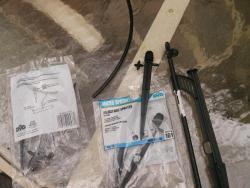Too bad you can't get an Extension service test, Tina. I did notice the Master Gardeners of Orange County (I've no idea if that's anywhere near you) suggest you can drop off a sample and also recommend some home test kits, I expect you've already seen this:
http://uccemg.com/Soils-Fertil...
Regarding what to test in addition to pH and NPK, I would include micronutrients, although if you think you have a nutritional problem you might be better getting a leaf analysis which tells you what nutrients are actually being taken up by the plant instead of what is in the soil (and which may not be in an available form). You're not as likely to have micronutrient deficiencies if your pH is around 6.5 or below (although if it too low that's another problem).
For the substrate question, the answer is no (if I'm understanding the question correctly). The natural environment for daylily rust is daylilies (and patrinia). An obligate parasite is one that can only feed and reproduce on living tissue. That's why rust dies out in cold climate winters because there is no living tissue. In cold winter climates in its native areas it can survive as "winter spores" and infect patrinia in the spring and persist that way but there isn't much patrinia in North America, like daylilies it is an Asian native.
Most fungal plant diseases are not obligate parasites, they persist on dead tissue as well (the facultative parasites). The reason given for the differences in nutritional response by Marschner are "based on the nutritional requirements of the two types of parasite. Obligate parasites rely on assimilates supplied by living cells. On the other hand, facultative parasites are semisaprophytes which prefer senescing tissue or which release toxins in order to damage or kill the host plant cells."
You can see how rusts feed from the internal cells from this diagram on my rust info site:
http://web.ncf.ca/ah748/diagra...
Hard to answer the relative amounts of NPK question because very little research has been done with daylily nutrition. I don't think I'd go along with the 4-8-12 during the high heat of summer, though. I don't think I'd go along with that ratio anyway unless it was suggested by a soil test. On occasion people have shared their soil (and leaf) test results with me when they've been having nutritional problems with daylilies and nearly always the NPK levels are high, even very high (the most common problem seems to be interveinal chlorosis, which is generally a pH induced micronutrient deficiency problem). In the absence of a soil test I would go along with the often recommended 3-1-2 ratio and not apply anything during high heat/drought, especially something high in soluble salts.
Yes, half the amount of 20-20-20 would equal 10-10-10 applied dry per square yard or whatever. Dilution with water wouldn't necessarily do the same thing unless you knew exactly how much you were giving per plant/area.
For rust resistance research I don't think it's so much lack of research that's the problem, quite a few studies have been done, but the sheer number of daylily cultivars "out there". There are too many to test and now we have the problem of different "races" of rust so a cultivar's resistance can vary depending which one they encounter.
Seedfork, the nitrogen increasing rust hasn't been tested on daylilies but has been tested on other Puccinia rusts (daylily rust fungus is Puccinia hemerocallidis) in field trials as well as lab tests. If you Google the keywords puccinia nitrogen you'll find some of the studies. But, there are so many other things that can impact rust infection such as cultural practices, temperatures etc., it is bound to vary from year to year in any case.
You'd have to apply quite a bit of Milorganite at 5-2-0 (edited - forgot to include that only 1.5% is water soluble N, the rest slow release) to come into the "excessive" nitrogen category. Quite a few people have mentioned not having rust this year due to the unusually cold winter, I don't know if your garden might have experienced that? Currently it is also too hot in some southern areas for much in the way of rust, or so I've been told.




